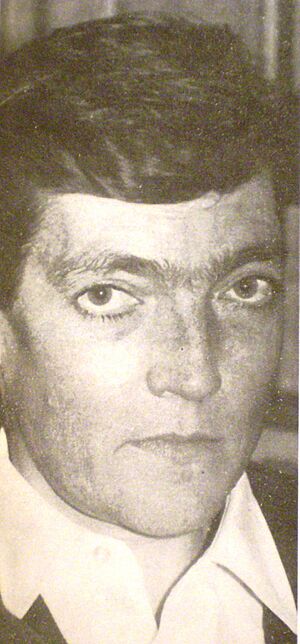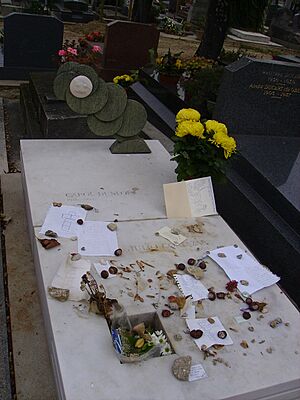Julio Cortázar facts for kids
Quick facts for kids
Julio Cortázar
|
|
|---|---|

Cortázar in 1967
|
|
| Born | 26 August 1914 Ixelles, Belgium |
| Died | 12 February 1984 (aged 69) Paris, France |
| Resting place | Montparnasse Cemetery, Paris |
| Occupation | Writer, translator |
| Nationality | Argentine, French |
| Genre | Short story, poetry, novel |
| Literary movement | Latin American Boom |
| Notable works | Hopscotch Blow-up and Other Stories |
| Notable awards | Prix Médicis (France, 1974), Rubén Darío Order of Cultural Independence (Nicaragua, 1983) |
| Signature | |
 |
|
Julio Florencio Cortázar (born August 26, 1914 – died February 12, 1984) was an amazing writer and translator. He was from Argentina but later became a French citizen.
Cortázar was one of the key figures in the "Latin American Boom." This was a time when many talented writers from Latin America became famous worldwide. He greatly influenced many Spanish-speaking readers and writers.
People remember him as one of the most creative writers of his time. He was a master of short stories and poetic writing. His novels changed how literature was made in the Spanish world. He often broke traditional rules, telling stories that didn't follow a straight timeline.
He spent his childhood and teenage years in Argentina. After the 1950s, he moved to Europe. He lived in Italy, Spain, and Switzerland for a while. In 1951, he settled in France. He lived there for over 30 years and wrote many of his famous books there.
Contents
Early Life of Julio Cortázar
Julio Cortázar was born on August 26, 1914. His birthplace was Ixelles, a town near Brussels, Belgium. His parents, Julio José Cortázar and María Herminia Descotte, were from Argentina. His father worked for the Argentine government in Belgium.
When Cortázar was born, German soldiers had taken over Belgium. Because of this, his family moved to Zürich, Switzerland. His mother's parents were waiting for them there in a safe, neutral country. The family stayed in Switzerland for two years. They lived in Zürich and then Geneva. After that, they moved to Barcelona for a short time. By the end of 1919, the Cortázar family settled near Buenos Aires, Argentina.
Julio's father left when Julio was six years old. The family never heard from him again. Julio grew up in Banfield, a suburb south of Buenos Aires. He lived there with his mother and younger sister. The house in Banfield, especially its backyard, inspired some of his stories. However, he once wrote that this time was "full of sadness."
He was often sick as a child. This meant he spent a lot of time in bed, reading. His mother knew several languages and loved to read. She introduced him to the books of Jules Verne. Cortázar admired Verne's stories for his whole life. He once said that his childhood felt "full of goblins and elves." He felt space and time differently from others.
Education and Teaching Career
Julio Cortázar became an elementary school teacher at 18. He then studied philosophy and languages at the University of Buenos Aires. But he had to leave because he needed to earn money. So, he didn't finish his degree.
Cortázar taught at two high schools in Buenos Aires Province. One was in Chivilcoy, and the other in Bolivar. In 1938, he published a book of poems called Presencia. He used the pen name Julio Denis for this book. Later, he said he regretted publishing it. He felt he should only publish books when he was sure they said exactly what he meant.
In 1944, he became a professor of French literature at the National University of Cuyo in Mendoza. But he resigned in 1946 due to political pressure. After that, he worked as a translator. He also directed a book trade organization called Cámara Argentina del Libro. In 1949, he published a play called Los Reyes (The Kings). It was based on the old Greek story of Theseus and the Minotaur. In 1980, Cortázar gave eight lectures at the University of California, Berkeley.
Years in France and Later Life
In 1951, Cortázar moved to France. He lived and worked there for the rest of his life. He traveled a lot, but Paris was his main home. From 1952, he worked as a translator for UNESCO. This is a part of the United Nations that promotes education, science, and culture.
He wrote most of his important books in Paris. He also had a home in Saignon, in the south of France. In his later years, he became very active in fighting for human rights in Latin America. He supported the Sandinista revolution in Nicaragua. He also supported Fidel Castro's revolution in Cuba and Salvador Allende's government in Chile.
Cortázar was married to Aurora Bernárdez, an Argentine translator, in 1953. They separated in 1968. He later had a relationship with Ugnė Karvelis, a Lithuanian writer. She encouraged his interest in politics. In 1981, he married Canadian writer Carol Dunlop. After Carol died in 1982, Aurora Bernárdez helped Cortázar during his final illness. She also inherited the rights to his works, as he wished.
Death of Julio Cortázar
Cortázar passed away in Paris in 1984. He is buried in the Montparnasse Cemetery. The cause of his death was reported to be leukemia, a type of cancer.
Works of Julio Cortázar
Cortázar wrote many short stories. These were collected in books like Bestiario (1951) and Final del juego (1956). In 1967, some of these stories were translated into English. The book was called End of the Game and Other Stories, later renamed Blow-up and Other Stories.
He also published four novels during his life:
- Los premios (The Winners, 1960)
- Hopscotch (Rayuela, 1963)
- 62: A Model Kit (62 Modelo para Armar, 1968)
- Libro de Manuel (A Manual for Manuel, 1973)
The novel Hopscotch is very special. It lets the reader choose how to read it. You can read it from beginning to end, or you can jump around. Other famous Latin American writers praised this unique style.
Cortázar's writing style was influenced by writers like James Joyce. He also took ideas from Surrealism, which is an art movement about dreams and imagination. He was also inspired by jazz music. This love for jazz is clear in his story "El perseguidor" ("The Pursuer"). This story was based on the life of a famous jazz saxophone player, Charlie Parker.
Cortázar also wrote poetry, plays, and non-fiction books. In the 1960s, he worked with artist José Silva. They created two special books that mixed text with photos and drawings. One of his last works was with Carol Dunlop. It was called The Autonauts of the Cosmoroute. This book tells the funny story of their trip from Paris to Marseille in a Volkswagen camper van.
As a translator, he translated many books into Spanish. These included Robinson Crusoe and the complete works of Edgar Allan Poe.
Influence and Legacy
Julio Cortázar's stories inspired many films. The famous film Blowup (1966) was based on his story "Las babas del diablo." This story was inspired by a photograph taken near Notre Dame Cathedral in Paris. Another film, Week End (1967), was influenced by his story "La autopista del sur."
Filmmaker Manuel Antín directed three films based on Cortázar's stories. These were Cartas de mamá, Circe, and Intimidad de los parques.
Many other writers have said Cortázar influenced them. Chilean novelist Roberto Bolaño said Cortázar was a key influence on his novel The Savage Detectives. Puerto Rican novelist Giannina Braschi used Cortázar's story "Las babas del diablo" in her novel Yo-Yo Boing!.
In Buenos Aires, there is a school, a public library, and a square named after Julio Cortázar.
Recording from the Library of Congress
- Julio Cortazar reading from his own work
Filmography
- La Cifra Impar, 1960. A film by Manuel Antín, based on "Letters from Mother."
- Circe, 1963. A film by Manuel Antín, based on "Circe."
- Blow Up, 1966. A film by Michelangelo Antonioni, based on "Las Babas del diablo."
- Cortázar, 1994. A documentary directed by Tristán Bauer.
- Graffiti, 2006. A short film based on Julio Cortázar's short story "Graffiti."
- Mentiras Piadosas (Made Up Memories), 2009. A film based on "The Health of the Sick" and other stories by Julio Cortázar.
See also
 In Spanish: Julio Cortázar para niños
In Spanish: Julio Cortázar para niños
- État second
- Sophie Bohdan




